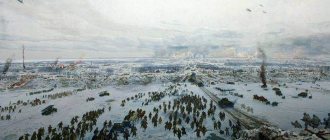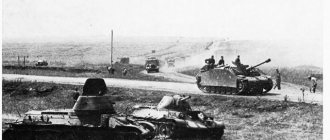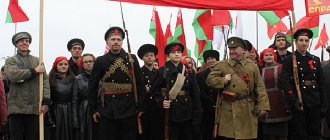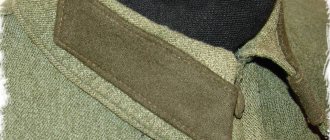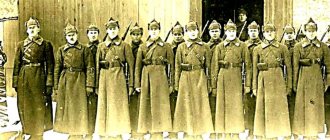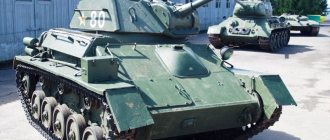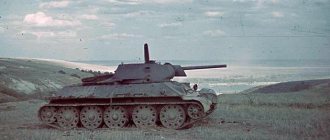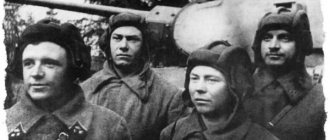↑ Creation of the front
The front was created by order of the Supreme Commander-in-Chief Headquarters on August 27, 1941, by dividing the Northern Front. It consisted of three armies 8, 23 and 48. The front was placed under the command of Lieutenant General M. Popov. But already in early September he was replaced in this post by Marshal K. Voroshilov.
The main task set for the front was to hold the enemy troops and prevent the capture of Leningrad, but on September 8 the Germans closed the blockade ring around the city. After these events, a new front commander, General G. Zhukov, was appointed.
Thanks to successful military operations, the soldiers managed to stop the advance of German and Finnish troops.
Divisions of the Red Army during the Great Patriotic War
The Leningrad Front was formed on August 27, 1941 on the basis of the Supreme Command Headquarters Directive of August 23, 1941 by dividing the Northern Front into two fronts - Karelian and Leningrad. The front included the 8th, 23rd and 48th armies, Koporye, Southern and Slutsk-Kolpino operational groups. On August 30, 1941, the Baltic Fleet was transferred to operational subordination to the front. On November 25, 1942, the 13th Air Army was formed from units of the front air force. Subsequently, the Leningrad Front included: 4, 20, 21, 22, 51, 52, 55, 59, 42, 54, 67th armies, 1st, 2nd and 4th shock, 6th and 10th Guards, 3rd, 13th and 15th Air Armies, Nevskaya and Primorskaya Groups of Forces.
The front was faced with the task of covering the immediate approaches to Leningrad and preventing it from being captured by the enemy.
By the end of September 1941, the active defense of the front troops stopped the German troops advancing on Leningrad from the south, and the Finnish troops from the north-west and inflicted significant damage on them. Since September 8, 1941, troops fought under extremely difficult blockade conditions. Subsequently, by stubborn defense, combined with offensive actions, they, with the assistance of the Volkhov Front and the Baltic Fleet, bled the enemy dry, forced him to go on the defensive and finally thwarted the plan of the Nazi command to capture Leningrad.
On January 12-30, 1943, troops of the Leningrad and Volkhov fronts carried out an operation under the code name “Iskra” to break the blockade of Leningrad south of Shlisselburg (Petrokrepost) and restored the city’s land connection with the country.
In January-February 1944 Front troops, in cooperation with the troops of the Volkhov, 2nd Baltic Fronts and the forces of the Baltic Fleet, defeated the German Army Group North near Leningrad and Novgorod, finally lifted the blockade of Leningrad, liberated the Leningrad and part of the Kalinin regions, and entered the territory of Estonia.
On April 24, 1944, the 3rd Baltic Front was created from part of the troops of the Leningrad Front.
On June 10-20, 1944, the troops of the Leningrad Front, with the active participation of the forces of the Baltic Fleet, the Ladoga and Onega military flotillas, successfully carried out the Vyborg operation, as a result of which the military-political conditions were created for the withdrawal of Finland from the war on the side of Germany.
In September-November 1944 The front part of its forces participated in the Baltic strategic operation (September 14-November 24), advancing in the Tartu-Tallinn and Narva-Tallinn directions. Having liberated the continental part of Estonia, front troops, in cooperation with the forces of the Baltic Fleet, cleared the islands of the Moonsund archipelago of the enemy from September 27 to November 24.
This completed the offensive actions of the front troops. His troops occupied positions on the Soviet-Finnish border and the Baltic Sea coast from Leningrad to Riga.
On April 1, 1945, part of the troops of the disbanded 2nd Baltic Front was transferred to the front and assigned the task of continuing the blockade of the Courland group of enemy forces.
In connection with the unconditional surrender of Germany, the Leningrad Front accepted the surrender of this group.
On July 24, 1945, on the basis of the Order of the NKO of the USSR dated July 9, 1945, the Leningrad Front was transformed into the Leningrad Military District.
Front commanders: Lieutenant General M. M. Popov (August-September 1941); Marshal of the Soviet Union K. E. Voroshilov (September 1941); General of the Army Zhukov G.K. (September-October 1941); Major General Fedyuninsky I.I. (October 1941); Lieutenant General M. S. Khozin (October 1941 - June 1942); Lieutenant General, from January 1943 - Colonel General, from November 1943 - Army General, from June 1944 - Marshal of the Soviet Union L. A. Govorov (June 1942 - July 1945)
Members of the Military Council of the Front: Corps Commissar N. N. Klementyev (August-September 1941); from February 1943 Lieutenant General, from June 1944 Colonel General Secretary of the Central Committee of the All-Union Communist Party of Bolsheviks A. A. Zhdanov (September 1941 - July 1945)
Chiefs of the front headquarters: Colonel Gorodetsky N.V. (August-September 1941); Lieutenant General M. S. Khozin (September-October 1941); Major General, from May 1942 - Lieutenant General D. N. Gusev (October 1941 - April 1944); Colonel General Popov M. M. (April 1944 - July 1945)
Source: Great Patriotic War of 1941-1945: Active Army. - M.: Animi Fortitudo, Kuchkovo Pole, 2005. - 664 p.
Share link:
Liked this:
Like
Tags: Leningrad front, fronts
↑ Military operations of the front during the siege of Leningrad
The troops of the encircled front undertook several operations:
- Strelninsko-Peterhof - was carried out from October 5 to October 10, 1941 together with the Baltic Fleet. It ended in complete failure due to insufficient elaboration of the operation plan.
- The Sinyavsk operation was carried out jointly with the Volkhov Front. The result of the operation was the disruption of the operation of the German troops “Nordlicht” for the final capture of Leningrad.
- Operation Iskra was carried out in January 1943 by the Leningrad and Volkhov fronts. The result of the operation was the breaking of the German blockade and the restoration of the city's land connection with the rest of the country.
- In the winter of 1944, in cooperation with the Second Baltic and Volkhov Fronts, German Army Group North was defeated, and thus the blockade from the city was finally lifted.
Ladders and hooks as infantry weapons
We tried to take everything into account. For example, in order not to lose control of the troops in battle, Dukhanov’s divisions were additionally equipped with radio stations.
Being an artilleryman by military specialty, Govorov formed several artillery groups of 1,870 guns and mortars - from long-range to counter-mortar. The Katyusha divisions were brought together into a separate group. There was also a place for a super-powerful 406-mm naval gun.
At some point, a problem arose: when the artillerymen began to fire at the enemy, a certain number of scattering shells would fall on the ice of the Neva and break it, preventing the crossing of their troops. What should I do?
Govorov proposed destroying targets on the left bank with direct fire guns. To do this, artillery reconnaissance officers carefully compared the photographic panorama of the enemy shore with the results of their observations.
In Simonyak’s division, an artillery reconnaissance officer, a young Leningrad decorative artist, Vasily Nikiforov, not only observed the enemy, but, hiding in a trench, sketched what he saw. Then he crawled to a new place, and in the evening he transferred the sketches to a four-meter panoramic canvas.
In total, the keen eye of the reconnaissance artist discovered 60 German firing points. Copies of his paintings were handed over to the commanders of divisions and batteries.
↑ Military actions of the front after the blockade was lifted
After the liberation of the city, the front moved to the border with Estonia. In the early summer of 1944, in cooperation with other tactical groups, the successful Vyborg offensive operation was carried out. Its result was the surrender of Finland.
The offensive against Tartu and Tallinn continued. Subsequently, mainland Estonia was completely liberated from the invaders. The Moonsund archipelago was also cleared of enemy troops. After this event, front troops no longer participated in active hostilities.
References
- ↑ a b c d ”
(undefined).
Ministry of Defense
(in Russian). Archived from the original on December 22, 2012. Retrieved May 16, 2022. - "Biography of Colonel-General Dmitrii Nikolaevich Gusev - (Dmitri Nikolaevich Gusev) (1894 - 1957), Soviet Union." www.generals.dk
. Consultado el 14 de abril de 2022. - "Biography of Colonel-General Vladimir Zakharovich Romanovskii - (Vladimir Zakharovich Romanovsky) (1896 - 1967), Soviet Union." www.generals.dk
. Consultado el 14 de abril de 2022. - "Biography of Lieutenant General Vladimir Petrovich Sviridov - (Vladimir Petrovich Sviridov) (1897 - 1963), Soviet Union". www.generals.dk
. Recommended March 26, 2022 - “Biography of Colonel-General of Aviation Stepan Dmitrievich Rybalchenko - (Stepan Dmitrievich Rybalchenko) (1903 – 1986), Soviet Union.” www.generals.dk
. Consultado el 14 de abril de 2022. - Zhukov, Georgy (1974). Marshal of Victory, Volume II
. Pen and Sword Books Ltd. With. 7. ISBN 9781781592915. - "Biography of Major General Nikolai Nikolaevich Klementyev". www.generals.dk
. Retrieved May 5, 2022. - "Biography of Colonel General Andrei Aleksandrovich Zhdanov". www.generals.dk
. Retrieved May 5, 2022. - "Biography of Lieutenant General Nikolai Vasilyevich Gorodetsky". www.generals.dk
. Retrieved May 5, 2022. - "Biography of Colonel General Mikhail Semenovich Khozin". www.generals.dk
. Retrieved May 5, 2022. - "Biography of Colonel General Dmitry Nikolaevich Gusev". www.generals.dk
. Retrieved May 5, 2022.
↑ Commanders of the Leningrad Front
The front command was carried out by:
- Lieutenant General Popov;
- Marshal Voroshilov;
- General Zhukov;
- Major General Fedyunensky;
- Lieutenant General Khozin;
- Lieutenant General Govorov.
From the very beginning of the German-Soviet war, the troops of the Leningrad Front found themselves in a surrounded city. Communication with the rest of the troops was practically cut off by the German occupiers. This, as well as the lack of ammunition, provisions, equipment and other things, explains the failures of the first military operations of the front. But thanks to the courage and dedication of the soldiers, the enemy failed to capture Leningrad and continued its offensive.
First, deal with the 67th Army of the Red Army
At eleven o'clock fifteen minutes the soldiers of the 2nd Shock Army went forward, and 15 minutes later - units of the 8th Army, delivering an auxiliary attack to the south.
Despite the powerful artillery attack, not all enemy firing points were suppressed. A significant number of tanks were blown up by mines, and the infantry advance through the winter peat bogs was difficult. All these factors immediately affected the pace of advance of the Volkhov Front.
German soldiers with a 7.92 mm MG-34 machine gun in a position near Leningrad
Photo: Nationaal Archief van Nederland
On the first day, only the 327th division of Colonel Nikolai Polyakov achieved success, capturing most of the German positions in the Kruglaya grove. The Germans put up fierce resistance in the center and on the right flank of the offensive, and the strongholds of Rabochiy Poselok No. 8 and Lipki could not be taken. They had to be avoided.
The offensive on a relatively wide front of the 67th Army attracted the attention of Lindemann, who decided that this was a weaker enemy than the 2nd Shock and would be easier to deal with. On January 12, the German general strengthened the defense by introducing separate battalions from the 61st and 96th Infantry Divisions, as well as the 5th Mountain Rifle, into the battle.
The next day, the fighting became particularly fierce, during which the parties exchanged fierce counterblows. The daily losses of the 67th Army amounted to 700-900 killed.
The Red Army, in very difficult terrain, literally chewed through the German defenses, which consisted of numerous bunkers, a developed trench system, the ruins of the 8th State District Power Plant, an almost impregnable bastion towering over the Neva
They also did not forget about the destruction of the main support of the German defense - its artillery.
On January 13, Govorov and Meretskov brought reserves into battle, including tank brigades, to increase the force of the strike. The deep echeloning of Soviet troops in Operation Iskra was one of the innovations that helped achieve success.
As a result, Fyodor Fetisov’s 256th Rifle Division from the 2nd Shock Division cleared the enemy from Rabochiy Settlement No. 7 and Podgornaya station and reached the approaches to Sinyavin.
The 372nd Division, under the command of Colonel Pyotr Radygin, captured Workers' Villages No. 4 and 8 and by January 17 was advancing on Workers' Village No. 1. Some of the heaviest battles ensued for Workers' Village No. 5, which was turned into a powerful stronghold with all-round defense. Its garrison numbered more than a thousand people.
Bibliography
- Salisbury, Harrison Evans (1970). 900 days of the siege of Leningrad
. Barcelona: Editorial Plaza & Janes. - Glantz, David M. (2002). Battle of Leningrad;
900 days under siege by the Wehrmacht . Wake up, Iron. p. 134. ISBN 978-84-946499-7-4. - Glantz, David M. (2017). Clash of the Titans: The Red Army's Victory over Hitler. Wake up, Iron. ISBN 978-84-945187-8-2.
- Jones, Michael (2016). Siege of Leningrad: 1941-1944. Barcelona: Critical Editorial. ISBN 978-8416771271.
- Zhukov, Georgy (1990). Memories and Reflections, Volume
I. Moscow, USSR: Progress Publishing House. ISBN 978-5010019501.
| authoritative control |
|
- Data: Q1635580
- Multimedia: Leningrad Front
Structure [edit]
When created in August 1941, the Leningrad Front included:
- 8th Army
- 23rd Army
- 48th Army
- Koporye operational group
- Southern Task Force
- Slutsk operational group
- Baltic Fleet
After November 25, 1942, the composition of the Leningrad Front constantly increased, it subsequently included:
|
|
